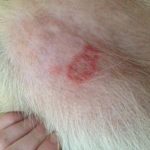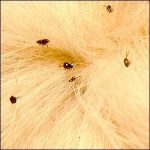Itchy skin in dogs is more than just a minor annoyance. Red, oozing bald patches, rashes are a real discomfort to dogs. The underlying cause needs to be determined so that these symptoms can be dealt with appropriately.
 Food allergies are one of the itchiest conditions in dogs. Animals eat a variety of food proteins that are processed inside their bodies into smaller pieces. Proteins can be combined or changed into substances recognized by the immune system as foreign invaders to be attacked. The resulting inflammation may target the gastrointestinal tract or other organ systems. In dogs, it is the skin that most often suffers from this immunologic activity. Dogs have facial itching, foot or limb chewing, itchy anal area and recurrent ear infections.
Food allergies are one of the itchiest conditions in dogs. Animals eat a variety of food proteins that are processed inside their bodies into smaller pieces. Proteins can be combined or changed into substances recognized by the immune system as foreign invaders to be attacked. The resulting inflammation may target the gastrointestinal tract or other organ systems. In dogs, it is the skin that most often suffers from this immunologic activity. Dogs have facial itching, foot or limb chewing, itchy anal area and recurrent ear infections.
Food allergies take time to develop. A recent food change will not cause itching due to a food allergy. Most animals have been eating the offending protein for years with no problem.
There is controversy as to how common food allergies are in dogs. Some experts feel that food allergies are rare while others feel they are much more common that we realize. There is no simple test for food allergy. The lesions on the skin are difficult to distinguish from that of airborne allergy which is often found in the same patient. Dogs can be allergic to insects (fleas, dust mites, storage mites), airborne proteins (molds, pollens) or foods.
Here are some tips that may help distinguish food allergies from other allergies.
- The itching is not seasonal. Most seasonal allergies get better in the winter. Food allergies do not change as the weather changes.
- Itching started when the dog was less than 6 months of age or greater than 5-6 years of age.
- No response to treatment for sarcoptic mange.
- Corticosteroids have not been helpful in managing the itching. Corticosteroids help with allergies other than food allergies.
- There are accompanying intestinal signs like vomiting and diarrhea. Vomiting and diarrhea occur in about 30% of food allergy cases.
- Most often see an itchy anal area and recurrent ear infections.
 It is imperative to control fleas. Many allergic animals can also be allergic to fleas.
It is imperative to control fleas. Many allergic animals can also be allergic to fleas.
To determine whether or not a food allergy or intolerance is causing the skin problem, a hypoallergenic diet is fed for a set period of time. If the dog recovers, the original diet is fed for up to two weeks to see if itching returns. If we see recovery from itching with the test diet and itch with the original diet, then food allergy is diagnosed. The dog then will need to eat the test diet or another similar commercial food. There is no other way to determine food allergies. Blood tests are not accurate.
Here are some additional concerns for diet trials.
- The diet must be strict. The dog should not have any other protein sources besides the test protein. This includes rawhides and chew toys. Heartworm preventative is flavored and should be used, instead use a topical or unflavored tablet. If any treats are given, they must contain the same protein as the test food.
- All family members must be on board with the trial. There can be no slipping food to the dog when others are not looking.
- It is probably best for all animals in the house to be fed the test protein so as not to have food-sharing issues.
- Itching must be managed during the trial in a way the results of the trial are not foiled.
- Diet trials often span a seasonal change. If a dog has an environmental allergy and winter comes during the diet trial, it may appear that the diet worked. When, the seasons simply changed. Therefore, diet challenge is important at the end, even if the dog is doing well.
There are two approaches to a test diet: novel protein and hydrolyzed protein. Traditionally, a novel protein is used. This is a diet with a single protein source that the dog has never eaten before. It takes years to become allergic to food protein so there should not be a problem with a new protein.
Nowadays, diets contain unusual protein and carbohydrate sources (kangaroo, bison, egg, peas, etc.). Diets used for allergy trials must contain one protein and one carbohydrate source and neither can be something that the dog has eaten before.
Several pet food companies have released limited ingredient diets that contain a single protein. These diets cost less than the prescription food that is found in your veterinarian’s office. While these diets are attractive, they are not a good choice for an actual diet trial. Immunological tests on these foods found that many of them contain additional proteins (contaminants form prior batches in the pet food factory). These impurities could defeat a diet trial which is hard enough to perform without such issues. The therapeutic prescription diets do not have these contaminants.
Home cooking is an alternative to commercially prepared foods for the diet trial. These diets need to be formulated by a veterinary nutritionist so that they are balanced and complete. It may also be a bit on an inconvenience.
There are also therapeutic diets made with hydrolyzed proteins that can be effectively used in diet trials. These diets use a conventional protein source that is broken down into molecules too small to excite the immune system.
Studies have shown that 80% of dogs have shown a response by 4-6 weeks on the diet. By extending the diet to 8 weeks, 90% will respond.
Food allergies are complicated but can make dogs miserable. Diet trials are the only way to determine if a food allergy exists and provide relief for your dog.
Recent Posts
Brunch & Bowl Tickets Now Available
DATE: Saturday, August 23, 2025 TIME: 11a.m.-2 p.m. (Bowling 12:30-2:30) PLACE: Pinstripes-South Barrington [...]
Lazy Dog Restaurant Fundraiser!
You can help As Good as Gold rescue golden retrievers [...]
Brunch & Bowl Tickets Now Available
DATE: Saturday, August 23, 2025 TIME: 11a.m.-2 p.m. (Bowling 12:30-2:30) PLACE: Pinstripes-South Barrington [...]
Lazy Dog Restaurant Fundraiser!
You can help As Good as Gold rescue golden retrievers [...]
Brunch & Bowl Tickets Now Available
DATE: Saturday, August 23, 2025 TIME: 11a.m.-2 p.m. (Bowling 12:30-2:30) PLACE: Pinstripes-South Barrington [...]
Lazy Dog Restaurant Fundraiser!
You can help As Good as Gold rescue golden retrievers [...]
Spring Membership Meeting – March 30, 2025
Calling all golden retriever lovers! Join As Good as Gold – [...]

